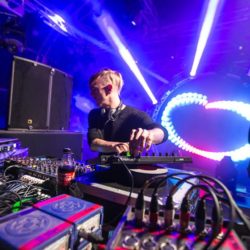If you missed it, check out Part 1, where Gene breaks down the traditional DJ setup.
Yesterday we touched on the “sync” feature found in the Native Instruments Traktor DJ software, which gives users the ability to DJ their music using a beat grid that matches and locks the tempo automatically.
To set up today’s piece on the features in Traktor, we discussed many of those features’ roots in the traditional DJ skillset. Most of the features found in DJ software emulate a real life skill that at one time, DJs spent countless hours learning how to execute. One of those features is the sync button, and today we’ll discuss this other and features found in Traktor that mimic the workflow of a traditional DJ.
The Traktor Setup
There are two main ways you can set up Traktor. You can operate “in the box” using a MIDI controller like the Native Instruments S4 to perform all the functions in the software. If you choose this method, you’ll forgo the use of a standard mixer and plug the controller into the house mixer, which runs the main sound.
If you choose the “outside the box” method, you will be using a Traktor interface such as the Audio 10 to route your signals into the existing DJ mixer. You will then be using the DJ mixer to control any equalizer and cueing functionality. I prefer this method because it works with a wide range of setups using different mixers.
Before using Traktor, you will need to take time to analyze your music. The analysis determines the length, tempo, key and tone of the song. Each of these attributes is displayed in a customizable section of the Traktor interface. Once your library is analyzed, you can start playing your music.
There are several ways to perform using Traktor. One method would be to use it as a DVS or Digital Vinyl System. A DVS uses a control surface like vinyl or CDs to send a signal to the interface. This signal is then converted into a control message for the music. Using Traktor as a DVS can emulate many of the functions of a real turntable such as scratching, stopping, speeding up and slowing down a song. Another function of a DVS is pitch. Pitch determines if the song will speed up or slow down based on the relative pitch of the control medium. This means that users can match the tempo of another song by using the pitch of the DVS, identically to the way it is performed using turntables or CDJs.
Another method to perform using Traktor is by not using any control surfaces at all, instead using the sync button to match the beats. There is still a great deal of work using this method, but it is more in the preparation, and less in the performance. This method has been a controversial topic in the DJ community, and I have heard many good points on both sides of the debate.
There are some detailed functions about Traktor, which can really help DJs in multiple ways. One major organizational plus about Traktor is its browser. Being able to sort your music library by over 20 different fields makes finding the right song at the right time that much easier. Another great feature about Traktor are its on-board effects. Traktor features over 20 different effects to give your music your personal stamp. DJs can use various delays and reverbs to create transitions that were previously unimaginable.
Over any other feature found in Traktor, I have found that the looping and cue-point functionality are the most useful to DJs, regardless of style. Depending on the genre you play, there may come a point where you need to loop a small section of a song so that it will mix with your next. Having this functionality is priceless when DJing genres such as hip-hop, which is known for notoriously short intros and outros. Another benefit is that when you have found a loop you like, you can then store it in the song by using cue points.
So, To Sync or Not To Sync?
The end of 2014 will mark the 18th year of my DJ career. I have seen many aspects of DJ technology come and go. Many try and change the game, and others simply try and enhance it. One thing that has been a constant is the need to mix music together to create an experience the listener cannot get in their normal listening environment. This means in DJing there will always be a need for a human touch.
The one thing that cannot be replicated by a button or computer program is the human heart. In my opinion, the main function of DJing is playing the right song at the right time for the appropriate venue. That skill can never be emulated by a button or computer program, and because of this I feel that no matter how many advancements are made in regards to technology, there is no substitute for a good DJ who understands music and how it relates and influences human emotions.
That being said, I started the first eight years of my career using only turntables. Once I started making my own music, I started incorporating CDJs into my sets. In 2006 I started to get all of my music strictly digitally, so I made the change to using Serato Scratch Live for all of my gigs. This was quite revolutionary for me because I no longer had to carry large, bulky record bags to my shows. A few years later, Native Instruments gave me a Traktor setup, and to be honest it just sat for a few months collecting dust. The interface was intimidating and seemed cluttered compared to Serato. A few months after getting it, a friend of mine showed me how to get the most out of Traktor. Just getting that brief explanation about Traktor, set me on the digital path, and it is hard to look back.
The type of DJ that you are or want to be, will determine what kind of setup you would like to use. Just remember that there is no “wrong” way. Traditionalists will always steer you toward the setup that works for them. Don’t hesitate to take things into your own hands and experiment with a new way of DJing. Who knows, you could be the next Ritchie Hawtin or Mix Master Mike.










Join the discussion
comments powered by Disqus